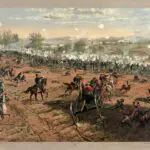The Civil War marked a revolutionary turning point for the United States in several areas, including the still-green field of photography. For the first time in history, the brutal realities of war were captured on camera and brought into the homes of ordinary Americans. Cameras were taken onto the battlefield, and the sorrows of maimed soldiers were brought starkly to life; no one could turn away, no way could regard the war with indifference.
This visual documentation not only influenced public opinion but also changed the way future conflicts would be recorded and remembered — this was the first war broadcast to the world.
If you would like to expand your American Civil War knowledge with visits to the most important battlefields of the conflict, book a Guided Tour of Virginia’s Battlefields.

The Advent of Photography in America
Before the Civil War, photography was still very much in its infancy. The invention of the daguerreotype in 1839 by Louis Daguerre was the first practical form of photography, producing detailed images on silvered copper plates. This early process was soon followed by the development of the ambrotype and tintype, which were cheaper and more durable.
In America, photographers like Mathew Brady were becoming well-known for their portraits of prominent figures (such as the first image of Abe Lincoln above). Brady, already a successful portrait photographer, saw the potential of using photography to document historical events. As tensions rose and the nation headed towards war, he prepared to capture the conflict in a way that had never been done before.

Mathew Brady: Pioneer of War Photography
Mathew Brady was a well-known portrait photographer before the Civil War. When the war began, he invested his own money to document it, assembling a team of photographers to cover different battlefields. Brady’s determination and vision led to a vast collection of war images.
Despite facing financial and logistical challenges, his work provided a comprehensive visual record of the Civil War, bringing the horrific reality of the conflict to the American public and solidifying his place in history as a pioneering war photographer.

The Role of Photographers and Their Techniques
Civil War photographers used the wet plate collodion process, which required portable darkrooms and large, heavy equipment. They traveled with the troops, setting up makeshift darkrooms in tents or wagons.
This process involved coating a glass plate with chemicals, exposing it in the camera, and developing it immediately. Photographers like Alexander Gardner, Timothy H. O’Sullivan, and George N. Barnard captured images that showed the war’s everyday miseries, from the deprivation of camp life to visits to the surgeon’s tent after being wounded on the field.
Iconic Photographs and Their Impact
Iconic photographs like “The Dead of Antietam” brought the veritable hell of the Civil War to the public. These images, often displayed in galleries or printed in newspapers, profoundly impacted viewers. For the first time, people could see the actual cost of the war—death, destruction, and suffering.
The harrowing images challenged romantic notions of war and influenced public opinion. The work of photographers like Brady and Gardner played a crucial role in shaping the nation’s understanding of the Civil War, making its tragic human cost undeniable.
The Challenges and Risks of War Photography
Civil War photographers faced numerous challenges and risks. They worked in dangerous conditions, often close to the front lines. The wet plate process required transporting fragile glass plates and chemicals, which were cumbersome and hazardous. Photographers also dealt with the physical and emotional toll of witnessing the war’s body count grow and grow. Despite these challenges, their dedication resulted in a powerful visual record that remains as valuable today as it was then.

The Legacy of Civil War Photography
The legacy of Civil War photography is profound. It established photography as a crucial tool for documenting history. The images captured by Brady, Gardner, and others influenced future photojournalism, setting standards for capturing the human experience in conflict.
These photographs remain valuable historical records, helping us understand the war’s impact. They continue to be studied, exhibited, and appreciated for their role in shaping American memory and history.
Are you inspired to visit key Civil War sites? Join our Guided Civil War History Tours in Virginia. If you have any questions, please get in touch.


